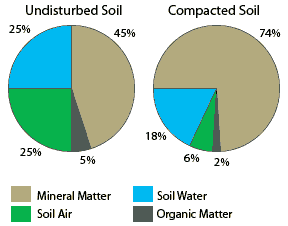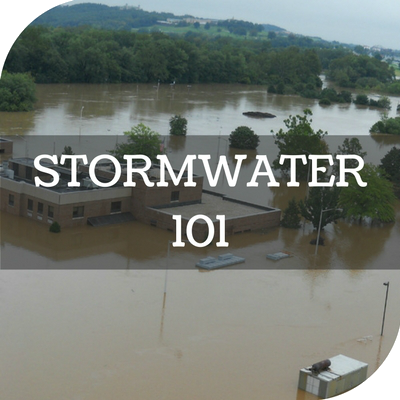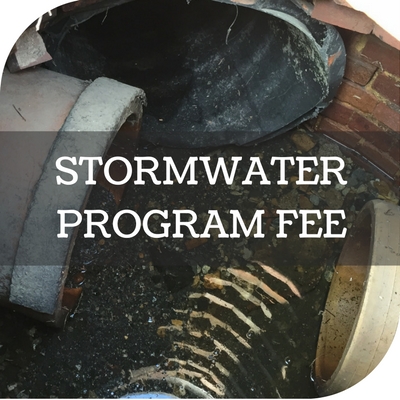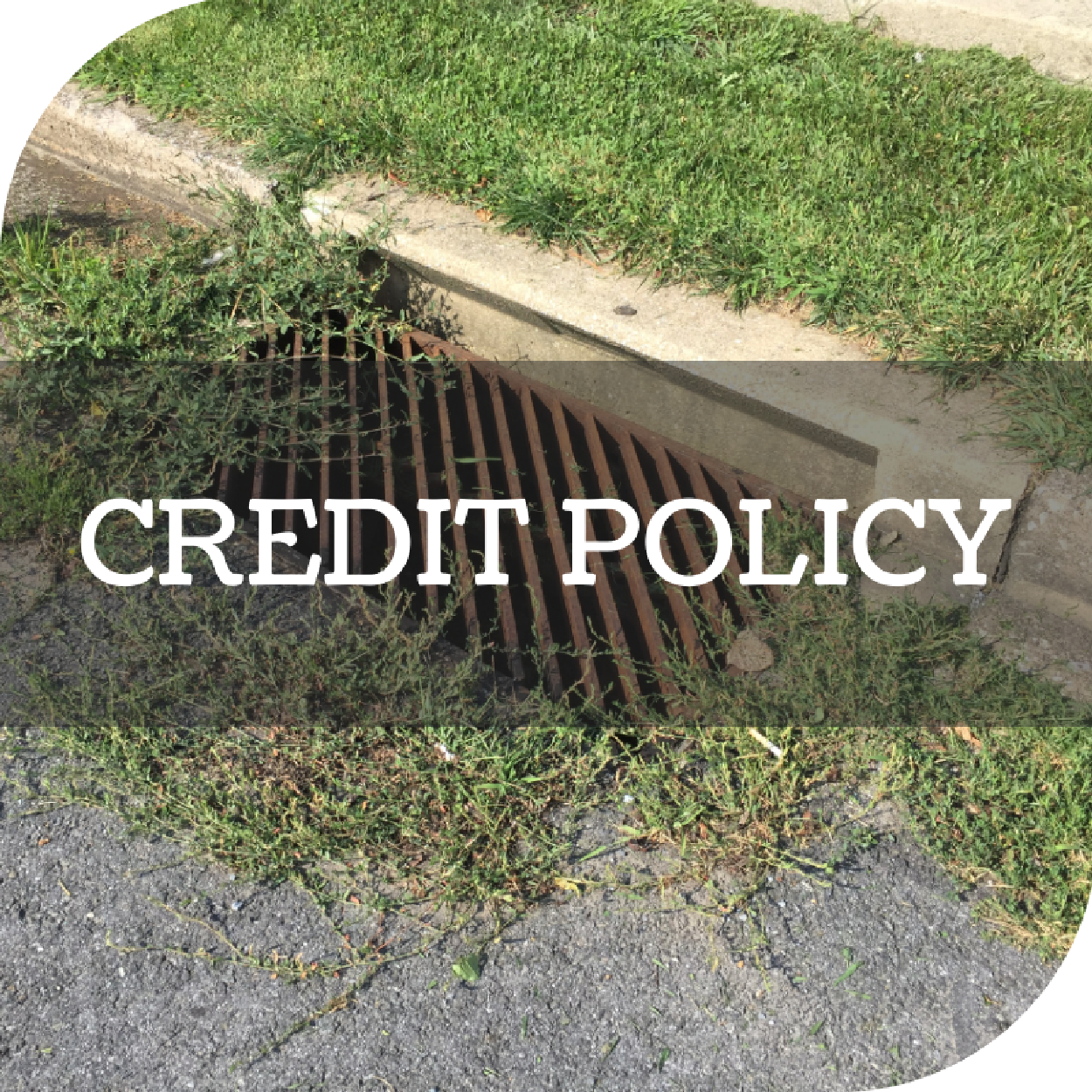
The Stormwater Minute
The Stormwater Minute provides short weekly articles to Derry Township residents about stormwater-related topics. It is our hope that these brief reads will raise awareness and knowledge on how stormwater impacts our community. You can read all our past articles below and you can find our latest Stormwater Minute by subscribing to the Township's eNews email newsletter.
The World’s Largest Filter - The Role of Soil in Stormwater Management
Effective stormwater management involves a multifaceted local community approach with a view toward regional watershed-level processes. This is because stormwater runoff is created by precipitation events that occur whenever and wherever storms develop. But, when you think about it, basic stormwater management utilizes engineering, science, and construction tools to develop site conditions that mimic the pre-development natural conditions. Why is that done? Because as it turns out, nature is pretty good at assimilating stormwater with plants and soil. So let’s talk a little about what’s so special about soil.
Although we typically think of soil as simply dirt, it is much more. Soil is really the foundation of all life and is something that affects us every day. From a narrow view point, soil is a media in which many things can occur including supporting the growth of plant life. As a media for stormwater renovation however, soil acts as a physical, chemical, and biological filter. By understanding the vital role of soil in stormwater renovation, more effective stormwater management strategies can be employed. Watch this short video developed for the International Year of Soils by the Soil Science Society of America to learn more about the role of soil in stormwater management.
The Root of the Solution - The Role of Plants in Stormwater Management
Stormwater is managed for quantity and quality, and plants play a major role in improving both. It’s no secret that plants provide ecological benefits, but sometimes we forget how crucial they can be in an effective stormwater management strategy.
When we employ engineered stormwater strategies, we are really trying to mimic some of the benefits plants provide a watershed when precipitation occurs. Picture in your mind the difference in water quality of runoff coming from a forested tract of land versus a recently plowed farm field. Neither of these land uses contain any impervious features such as houses, parking lots, or sidewalks, but the difference in runoff quality and quantity is striking, and a powerful example of what plants provide in an ecosystem.
In the past, stormwater management strategies attempted to mitigate the effects of plant removal by storing and slowing releasing stormwater from a developed site (think detention pond). Although that type of stormwater best management practice (BMP) can provide some benefits, the beneficial utilization of plants is unfortunately missing. Today, there are many ways site developers can incorporate the power of plants into an overall stormwater management strategy.
The strategic placement of trees, shrubs, and other plantings can help slow down and capture some of the precipitation adjacent to impervious areas of the site as it falls to the ground, eventually returning the water into the atmosphere through evapotranspiration. The placement of vegetated swales can help direct the flow and infiltration of stormwater along portions of the site while also providing an opportunity for nutrient and sediment uptake. The use of rain gardens or bioretention BMPs can replace traditional open detention or infiltration basins, providing similar but much improved water quality function. Beyond all of that, plants provide for an aesthetically pleasing landscape and provide much needed habitat for a whole array of wildlife.
Haste Makes Waste – The Role of Time in Stormwater Management
Ben Franklin is credited with imparting a lot of wisdom, but who knew his famous quote, “haste makes waste” would teach us something about stormwater management? Part of a sound stormwater management approach is making sure that hasty stormwater slows down to avoid flooding and to allow time for plants, soil, and microbes to clean up the waste.
Goal #1 of stormwater management is to control the volume of water coming off impervious surfaces so that it doesn’t all end up in our waterways at the same time and cause flooding. Goal #2 is to give plants, soil, and the soil microbes time to process the nutrients and pollutants that are contained in the stormwater. These goals are usually accomplished by providing some amount of temporary storage (think basin, rain barrel, or rain garden) and a means for plants, soil, and microbes to come in contact with the stormwater (think infiltration through the bottom of the basin, watering your flowers with the rain barrel water, and the organically-rich growth media full of plants and microbes in a rain garden).
Ben Franklin also said “fish and visitors stink in three days”, and once again his logic applies to stormwater. Although we want stormwater to hang around long enough to avoid flooding and get cleaned up, we don’t want it hanging around too long and providing habitat for breeding mosquitoes, stressing the plants that help clean it but may not like being continuously waterlogged, and avoiding unsightly or unsafe conditions around our community. To avoid all those unpleasant things, stormwater BMPs are designed to empty within three days. Who knew time management was so important to stormwater management?
Connecting the Stormwater Dots – Source versus Transport
If you look around your neighborhood or as you’re driving through the Township, I’m sure you’ve noticed the grates along roadways. These grates are called inlets, and they are a conduit to take the stormwater that is generated on that road and surrounding properties somewhere else. They were put there because we didn’t want the water to hang around and cause flooding, property damage, or create unsafe conditions. But where does it go?
Honestly, most people probably don’t give it another thought, and that is certainly understandable. However, rest assured, where there’s an inlet eventually there’s an outlet. Some people think that water heads to a water treatment plant, but that is not the case. The water ends up in our streams. There’s no treatment plant, no filter, nothing.
What’s the big deal with water being directed to a stream? That sounds like a good place for it, right? The problem is that the water is not clean water, it’s picked up whatever nutrients, sediments, and pollutants were in its path. It’s those things that we don’t want in our streams. Streams that we use to swim, fish, and supply our drinking water. So next time you’re washing your car and the rinse water heads to the nearest inlet or you finish painting and that inlet looks like a convenient place to dump the extra paint and wash the brushes, remember, it’s like you were washing your car or paint brushes right in the stream. There’s nothing wrong with washing a car or painting, but when you connect the source to a mode of transport, good things become bad things. Try washing your car in a grassed area of your yard or take it to a commercial car wash where they recycle the water. When using paint and other household chemicals, cleanup and dispose of wastes in proper receptacles. Remember, you have the power to limit what ends up in our streams.
Stormwater Ruined my Summer Vacation
Maybe you’re planning a trip to the beach, a lake, or even the Summer Olympics in Rio De Janeiro this summer. Trips like those are a great way to unwind from the stresses of life and partake in some great outdoor fun. Unfortunately, many of our favorite destinations are experiencing the ill effects of inadequate stormwater management.
The Summer Olympics are being plagued by reports of poor water quality in some of the same waters our athletes will be competing. Reports of bacterial and viral concentrations as high as 1.7 million times levels acceptable in U.S. waters have been reported. Additionally, reports on the presence of garbage in the water indicate rowing and sailing teams are having to navigate around such things as couches, television sets, and other discarded items.
Myrtle Beach South Carolina has been under a Long Term Advisory from the State Department of Health and Environmental Control warning people that swimming is not advised in areas around stormwater outfalls because of high bacteria levels. Florida’s “Treasure Coast” is experiencing a massive toxic algae bloom which has caused Florida’s governor to declare a state of emergency in some counties and even ask for help from the Federal Government. The algae bloom stems from Lake Okeechobee, where nutrient- and pollutant-laden runoff caused the formation of an algal bloom that was released to the ocean when the Army Corp of Engineers were forced to discharge water from the lake to avoid the potential for flooding from recent high rainfall events.
Unfortunately, these events aren’t isolated or uncommon. The list could go on and on. The point is that if we don’t focus on the issue of stormwater management when it’s a small problem, we will eventually get smacked in the face when it is a big problem. Big problems are always costlier to repair than small problems. If you don’t believe me, just ask the elected officials in Brazil, Myrtle Beach, and Florida.
Soils Need to Breathe Too
Did you know soils breathe? They also drink water. Now imagine yourself trying to breathe or drink a glass of water while someone is stepping on your throat. Not a pleasant image or a scenario where you’d be very successful at either task. Well, that’s exactly what soils experience when they are compacted.
Soils are comprised of four main components: mineral matter (sand, silt, and clay), organic matter, air, and water. Soil air and water are present in soil pores. Soil pores are the spaces between the mineral and organic matter particles. About half of a volume of soil is comprised of pore space. It’s within these pore spaces that air and water move about. When it rains and water infiltrates into the soil, it’s entering this pore network by displacing the air.
In stormwater management, we like to get the precipitation to infiltrate into the ground to reduce runoff and aid in renovation. The more pore space a soil has the more water it can infiltrate. That’s why compaction is such a problem for soils. When soils are compacted, the mineral portion gets compressed and the pore space is reduced. That results in soils that have much less overall pore space. Note how pore space is reduced from 50% to 24% between the “undisturbed soil” and the “compacted soil” in the two pie charts.

Fixing Soil Compaction
“Sometimes you just can’t turn back the clock,” a simple statement that speaks volumes. Perhaps you can remember a time when something you treasured broke, or if you have kids inevitably one of them brings you one of their beloved toys, irreparably broken, with that look in their eyes that says “fix this please”. No matter how much you want to make it as good as new, sometimes the best you can do is get some duct tape and cross your fingers.
When it comes to soil compaction, turning back the clock can be just as problematic. It’d be nice if all you had to do was give the soil a good shake - like fluffing up an old pillow. Unfortunately, once the damage is done, the best you can do is mitigate some of its effects, so ultimately the best way to fix compaction is to not cause it in the first place. Great, all we have to do is never walk, drive, or build on soil anymore. Now that we solved that problem we can move on to world peace. All kidding aside, whether we like it or not, we’re part of the environment and therefore we have an impact on the environment, including the soil. So what can we do?
Although we might not be able to eliminate compaction, we can take some steps to minimize and mitigate it. During project planning, think through the construction process and design it so you aren’t unnecessarily moving equipment over the soil. As you finish portions of the project, back the equipment out, scarify the soil as you go to break up any compaction you might have caused. Incorporate organic matter, like compost, to mitigate the effects of compaction and help prepare a suitable planting environment. Happy plants will eventually remedy many of the ill-effects of compaction, and organic matter makes plants happy. Basically, just have a plan, because as Zig Ziglar said, “if you aim at nothing, you’ll hit it every time”.
Water Movement Over Landscapes and Time
Have you ever stopped to think about how water moves across a landscape? Some may say, “water flows downhill”, which is often but not always the case (stay tuned next time for more on that). The reality is that when our brains start trying to conceptualize something complex, we tend to find a way to simplify it for easier comprehension. That’s fine for general thinking, but when we start trying to address issues like flooding and water quality, how we frame our solution is dependent on how accurately we conceptualize the problem.
Enter Variable Source Area (VSA) Hydrology, the concept that the majority of runoff exiting a watershed is driven by a relatively small portion of the watershed. When we talk VSA hydrology, we use terms like saturation excess overland flow and infiltration excess overland flow. Stay with me, as it will all become as clear as mud soon enough. Saturation excess flow occurs when the soil becomes saturated and any new precipitation cannot enter the soil because there’s no more room in the soil pores. Think of this as trying to get tickets to a sold-out concert. The venue can only serve so many people that day, all others have to go find something else to do. Infiltration excess flow occurs when the rate of precipitation exceeds the infiltration rate of the soil. This is like trying to go out to eat at a restaurant but there’s a 45-minute wait. The restaurant can eventually feed you, but you’ll probably move on to another restaurant instead of waiting. When precipitation hits saturated ground or falls faster than it can infiltrate into the soil the excess becomes runoff and that’s the focus of a Stormwater Management Program.
What VSA hydrology shows us is when and where each type of flow is dominate on a landscape, just like a schedule of community events tells us when and where traffic might be an issue. Stadium owners don’t staff their parking lots 24/7 because they don’t host concerts and sporting events 24/7. Doing so would be an inefficient use of their resources. The same principle applies to mitigating the effects of stormwater. If we understand how water movement occurs across a watershed we can focus our resources on the areas where they’ll be most effective.
Water Flow in Soils
We've talked about landscape-scale water movement and how that affects our Stormwater Management Program. Now we’re going to look at how water moves through soils on a local scale and how those mechanics can affect water quality. We’ve mentioned before that soils have pores: space in soils where air and water can go. When it begins to rain, water moves into soil pores through unsaturated flow. Unsaturated flow means the pores in the soil are not completely full of water. As it keeps raining, more and more water moves into the soil pores until they fill up, or in other words, become saturated. At this point, we refer to the movement of water as saturated flow.
The pores in soils come in all sorts of shapes and sizes. Some pores are small and some are big. As you can imagine, big pores can move more water and move it faster than small pores, just like highways move more cars faster than local roads. Water only moves through big pores during saturated flow and does so under the influence of gravity (water flows downhill). In unsaturated flow, water is pulled toward the soil by forces of attraction (not the romantic kind) that are greater than the force of gravity. If you’ve ever stuck a sponge in water and watched it soak “up” the water, you’ve seen this principle in practice and witnessed “water flowing uphill”.
When we concentrate stormwater on a landscape we create conditions that lead to saturated flow, which leads to water quickly moving through soil by gravity, and potentially not having enough time for the soil microbes to help breakdown and retain some of the pollutants. When we spread stormwater across a larger land area, the water is pulled into the soil by attractive forces associated with the soil particles and unsaturated flow occurs. Because the soil is “pulling” the water, the water and associated pollutants are retained in the soil longer allowing microbes time to breakdown the pollutants. Think about that next time you forget to turn off your lawn sprinkler!
A Closer Look at Stormwater Basins
We’ve all seen them, the open grassed areas adjacent to development that look like a pond that someone forgot to fill with water. Then it rains, and that dry open area fills with stormwater. Then days later, it’s empty again. Obviously, the basins were designed to hold stormwater, but why do we need to hold stormwater and how do these basins drain once they fill up?
Although basins may all look the same, there are actually several different types. One type is known as a retention pond. Retention ponds are designed to constantly hold water. We’re going to focus on two other types of basins that are designed to momentarily hold water – detention and infiltration. Detention basins are designed to allow stormwater to enter and then exit through a small hole or orifice. The orifice is sized to send the water out at a rate that won’t aggravate downstream flooding and that won’t allow the water to hang around too long and be a breeding ground for mosquitos. The water that leaves a detention basin eventually makes its way to a stream.
An infiltration basin allows water to enter just like a detention basin, but does not have an outlet orifice to allow water to exit the basin. Stormwater that enters an infiltration basin must exit by infiltrating into the underlying soils (hence the name). As we’ve discussed in a past Stormwater Minute, stormwater that enters the soil gets physically filtered by the soil and chemically and biologically filtered by the microbes that live in the soil. That filtered water eventually makes its way into the groundwater, helping to replenish that valuable underground resource. Remember, both detention and infiltration basins hold back a volume of stormwater so that it doesn’t aggravate flooding. Detention basins let the captured water enter a stream at a controlled rate, and an infiltration basin returns that water to the groundwater aquifer. So next time you walk past a stormwater basin, see if you can tell if it’s a detention or infiltration basin.
Tropical Storm Lee
We are about a week removed from the 5-year anniversary of Tropical Storm Lee that caused extensive flooding and property damage to our region on September 7-9, 2011. The Swatara Creek crested at 27 feet, more than 10 feet above the previous high as a result of more than a foot of rainfall over those few days. It was a powerful reminder of why stormwater management is a critical community need. PennLive put together a slideshow and short news article for the 5th anniversary. HRG Inc., the Township Engineer, put together a short video that features many images from Derry Township.
Fall Fertilization
Did you know that 90% of residents within the Chesapeake Bay watershed live within 0.5 miles of surface water and that turf is the #1 “crop” in the Chesapeake Bay watershed? That means how you manage your lawn matters, as it is highly likely to end up in a nearby surface water that eventually makes it to the Bay. Even if we weren’t in the Bay watershed, our local streams are receiving those pollutants, so it’s important to keep that in mind when conducting lawn maintenance.
Chances are, you only need to apply fertilizer once a year (or not at all), and that time is now. Fall is the perfect time to apply fertilizer. Listen, you aren’t a bad person if you fertilize more than once a year or for that matter if you don’t fertilize at all. Assuming you aren’t bagging and removing the clippings, chances are your lawn may not even need fertilized because those clippings act as a slow release fertilizer. Don’t overdo it when you do fertilize, you shouldn’t apply more than 0.9 pounds of total nitrogen per 1,000 square feet. Speaking of square feet, make sure that area only includes your lawn! If you get some fertilizer on the sidewalk or your driveway, take a broom or use a leaf blower and get it back onto your lawn. If your lawn is adjacent to a surface water body, leave a buffer when you fertilizer of about 15 feet.
Not sure if you need to fertilize? Get a soil test done for your lawn. Besides telling you what nutrients you might need, the soil test will also tell you if your soil is too acidic and needs lime. Lime helps raise soil pH and can make certain nutrients more available for uptake by plants. The only thing a soil test can’t measure well is nitrogen. However, good news, you can do that yourself. Nitrogen helps keep plants looking green, so just peak out your window and see if your turf is looking yellow. Be careful though, we’re not talking about the kind of yellow that develops when the turf goes dormant during dry spells, we’re talking about the kind of yellow that appears when your neighbor’s lawn looks green and lush and yours isn’t. Remember, smart turf maintenance is good for the environment and your wallet!

Pick up a newspaper, turn on the news, or scan your Facebook feed and you’re sure to come across a discussion on the variety of footprints we as humans are imprinting on our environment. Certainly many people have heard about carbon footprints, but have you ever thought about your stormwater footprint?
What is a stormwater footprint?
Just like many other types of environmental footprints, your stormwater footprint is the byproduct of all the activities you engage in on a daily basis that ultimately contribute to the quality and quantity of stormwater. Certainly the obvious contributors are things like the dwelling you live in or the roads you drive on, but some of the less obvious contributors might be when you fertilize your lawn, if you pick up after your pets, or where you wash your car and what products you use to wash it. What can seem as inconsequential individual daily tasks can have a profound positive impact when a whole community starts to think about and ultimately carry out modifications to those activities.
What size shoe are you wearing?
It’s really hard to fix anything if you don’t know what the problem is. If your kitchen faucet was leaking, you wouldn’t begin by tearing out all the plumbing in your house. The same thing is true for adjusting your stormwater footprint. By taking inventory of the things that contribute to the size of your impact, you can determine what small changes might lead to big results. A great way to start is by jotting down a list of things in your life that contribute to either generating stormwater runoff and/or adding pollutants to that runoff. We’ve already mentioned your home and roads, but what other impervious surfaces do you encounter on a day-to-day basis? What kinds of things are you doing that are potentially introducing nutrients or pollutants to the environment?
Having an impact by reducing your impact
Ok, now that you have your list, scan it for ways to reduce or eliminate negative contributions to stormwater. For example, you aren’t going to tear down your house, but you could install a rain barrel to your roof downspout or divert your downspout from discharging directly into a storm sewer. Do you have a lawn? Did you know that turf grass is the most abundant crop grown in the Chesapeake Bay watershed? How about getting a soil fertility test done to see what nutrients your lawn really needs instead of just applying whatever’s in the bag of fertilizer you buy at the store. When you are applying fertilizer, think about the potential exit points of your yard and limit fertilizer applications in those areas. For example, maybe you have a small swale or stream in your backyard. Create a natural vegetative or grass buffer along those areas (commonly called a “Riparian Buffer” by us stormwater geeks) and limit or eliminate fertilization in those areas. Remember, fertilization isn’t a bad thing, it just becomes a bad thing when those nutrients that are intended for your turf end up in the nearby stream. Don’t forget about the stormwater inlets on your street. Just because you might not have the Swatara Creek in your backyard doesn’t mean that water from your property doesn’t make its way there through the stormwater piping underground. Remember, there are two sides to the stormwater coin, source (potential contaminant) and transport (can it get there).
What can I do today to begin to reduce my stormwater footprint?
As fun as it is to talk about stormwater (don’t pretend you don’t like it), nothing changes until we do something. Here are some actionable items you can do to make a difference when the rain hits the road.
Map out your impervious areas and plan changes around your residence with this online interactive tool found at http://www.stormwaterguide.org/.
Grab a soil sample from your yard and have it analyzed for nutrient and lime needs by picking up a soil test kit from your local County extension office or garden center. More information can be found here http://agsci.psu.edu/aasl/soil-testing/soil-fertility-testing.
Wash your vehicle in your lawn instead of on a hard surface like your driveway or street, or take it to a commercial car wash that recycles their water.
Pick up after your pets. This means at your residence and when you take them for walks. Not only will it keep your neighbors happy, it will remove a source of nutrients and pathogens from entering our streams.
Mulch your grass clippings when mowing or if you bag the clippings, compost them. Don’t throw them in the street or into a stream where they can contribute excess nutrients.
Don’t litter. What you throw on the ground ends up in a stream eventually. Properly dispose of your trash and cigarette butts.
Never dump anything in a stormwater drain. Only rain in the drain!





